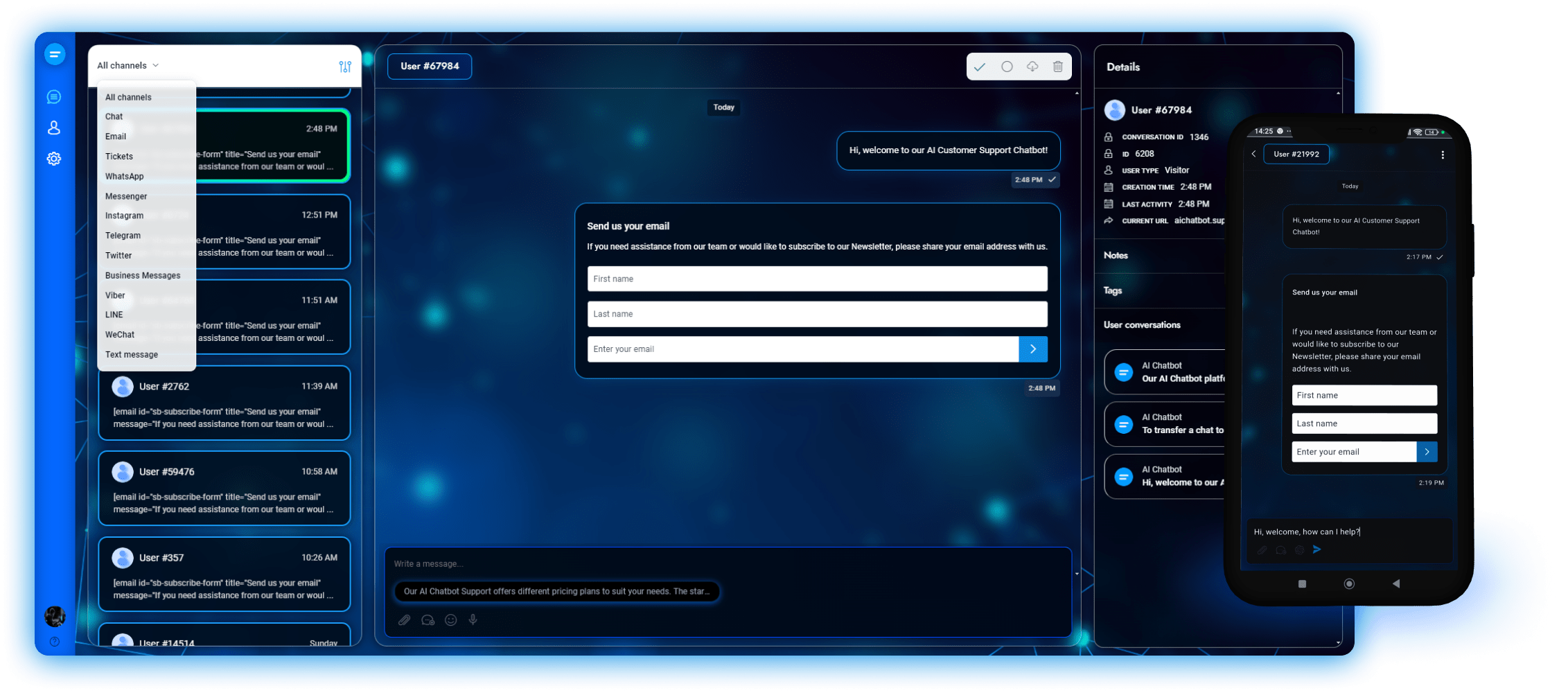Maximizing ROI with AI Chatbots

The ROI Potential of AI Chatbots
In today’s hyper-competitive business environment, maximizing return on investment (ROI) is not just a goal; it’s essential for survival. As organizations increasingly turn to technology to streamline operations, enhance customer experiences, and reduce chatbot.support/pricing">costs, AI chatbots have emerged as a critical asset in achieving these objectives. The integration of artificial intelligence and natural-language processing has redefined interactions between businesses and customers, delivering profound economic benefits across various industries. Here’s an exploration of why and how AI chatbots are becoming ROI-boosting powerhouses.
The Cost-Efficiency of AI Chatbots
The fundamental appeal of AI chatbots lies in their ability to dramatically reduce operational costs. Unlike human agents, chatbots can work round the clock without breaks, holidays, or overtime pay. They are capable of handling thousands of interactions simultaneously, ensuring that customer inquiries are addressed promptly without requiring a large workforce. This not only cuts down labor costs but also enhances customer satisfaction through immediate responsiveness.
A study by Juniper Research predicts that by 2023, the adoption of chatbots across retail, banking, and healthcare sectors will save businesses $11 billion annually. These savings stem from automation of front-office functions, which otherwise require significant human labor. By reducing dependence on human agents for routine queries, organizations can reallocate their human resources to more complex and revenue-generating activities, maximizing the value derived from their workforce.

Enhancing Revenue Generation
Beyond cost-cutting, AI chatbots contribute to revenue growth in several ways. By engaging with customers 24/7, chatbots can capture sales opportunities that would otherwise be missed during off-hours. Their ability to provide personalized recommendations based on customer interactions increases the likelihood of upsells and cross-sells, thereby boosting sales volumes.
Moreover, AI chatbots play a significant role in improving customer retention rates. The quick and efficient service they provide enhances overall customer satisfaction, a critical determinant of customer loyalty. A satisfied customer is more likely to become a repeat buyer and advocate for the brand, indirectly contributing to revenue enhancement through word-of-mouth marketing.
Data Analytics and Decision Making
One of the most significant benefits of AI chatbots is their ability to collect and analyze vast amounts of data from customer interactions. Every question, feedback, or complaint handled by the chatbot becomes a data point that can be used to derive actionable insights. Businesses can leverage this data to identify customer trends, pain points, and preferences, which can inform product development, marketing strategies, and customer service enhancements.
By understanding customer behaviors and adapting operations accordingly, businesses can not only meet but exceed customer expectations, ensuring their competitive edge in the market. The predictive analytics abilities of AI chatbots allow businesses to forecast future trends and prepare accordingly, minimizing risks and maximizing opportunities for growth.

Optimizing AI Chatbots for Maximum ROI
Successful utilization of AI chatbots goes beyond just integrating them into your customer service framework. An optimized deployment, tailored to meet specific business objectives and designed around the user experience, can dramatically amplify the returns. Here’s how organizations can strategically implement AI chatbots for maximum ROI.
Customization and Personalization
One size does not fit all when it comes to AI chatbots. The chatbot that delivers significant ROI is the one customized to understand the specific needs of a business’s target audience. Customization includes training the chatbot with industry-specific knowledge, configuring it to handle common queries effectively, and enabling it to interact in a tone that reflects the brand’s voice.
Additionally, utilizing AI chatbots’ ability to personalize interactions can substantially increase customer engagement and satisfaction. By accessing customer data and previous interaction histories, chatbots can deliver tailored recommendations and support, making each customer feel understood and valued.
Integration Across Multiple Touchpoints
To truly harness the power of AI chatbots, businesses must integrate them across all customer interaction points – not just on their website but on social media platforms, mobile apps, and even through voice-assisted devices. This provides a seamless and consistent experience for customers, regardless of the communication channel they choose.
Moreover, integrating chatbots with backend systems like customer relationship management (CRM) and enterprise resource planning (ERP) systems can enhance their functionality. This integration enables chatbots to perform complex tasks such as checking order status, updating customer information, and even scheduling appointments, so they are more valuable to users.
Continuous Learning and Improvement
AI chatbots are powered by machine learning algorithms, which means they have the capability to learn and improve over time. Continuously training your AI chatbot with new information and customer interaction data can significantly enhance its accuracy and efficiency.
It’s also important to regularly audit and review the performance of chatbots. Identifying areas where the chatbot may be underperforming or where user interaction drops off can provide critical insights. These insights can be used to fine-tune the chatbot’s responses and improve its decision-making algorithms, ensuring the chatbot evolves in line with customer expectations and business needs.
Employee Training and Change Management
Finally, for AI chatbots to be truly effective, it’s crucial that they are embraced by the human team they are designed to assist. Employees should be trained on how to use chatbot insights effectively and how to intervene seamlessly in conversations when necessary. Organizational change management is essential to foster acceptance and encourage the use of new technologies among staff.

Monitoring and Refining Strategies
To ensure the sustained success and maximization of ROI from AI chatbots, continuous assessment and adaptation of strategies are paramount. Here’s how businesses can evaluate the effectiveness of their AI chatbot implementations and refine their approaches for even better outcomes.
Establishing Key Performance Indicators (KPIs)
Before gauging the success of AI chatbots, businesses must define what success looks like. This involves setting clear, measurable key performance indicators (KPIs) related to both financial and customer satisfaction metrics. Typical KPIs might include reduction in customer service costs, improvement in response times, increase in sales conversions via chatbot interactions, and enhancement of customer satisfaction scores.
These metrics provide tangible benchmarks against which the performance of AI chatbots can be measured. Regular monitoring of these KPIs will help businesses understand the effectiveness of their chatbot initiatives and identify areas for improvement.
Leveraging Analytics for Insightful Feedback
The integration of advanced analytics tools with AI chatbots can offer deep insights into customer preferences and behavior patterns. By analyzing conversation data, businesses can identify frequently asked questions, common customer issues, and even sentiments expressed during interactions. This information is invaluable as it allows businesses to adjust their service strategies to better meet customer needs and to fine-tune their chatbot’s responses.
Moreover, sentiment analysis can reveal the emotional tone of customer interactions, providing clues on how customers perceive the brand and their level of satisfaction. This feedback is essential for improving chatbot interactions and overall customer experience.
Iterative Improvements and Scaling
AI chatbots should not be a ‘set it and forget it’ solution. Based on continuous data collection and feedback, businesses should employ an iterative approach to improve their chatbot systems. This could involve refining the natural language processing capabilities, expanding the chatbots’ knowledge base, or enhancing integration with other business systems.
As ROI begins to manifest, scaling the implementation becomes the next step. This could mean expanding the chatbot’s roles to other areas of business, such as procurement, HR, or internal IT support, or deploying it in additional markets or languages to support wider business operations.

Future-Proofing Through Innovation
Staying abreast of technological advancements is critical. Emerging technologies like predictive analytics, machine learning, and natural language understanding continue to evolve, and keeping your AI chatbot at the cutting edge can provide a significant competitive advantage. Investing in ongoing training and development for both the chatbot and the team managing it ensures a future-proof strategy that adapitates to both technological advancements and shifting market dynamics.
In conclusion, AI chatbots offer a remarkable opportunity for businesses looking to boost their operational efficiency and enhance customer experiences. By thoroughly understanding their potential, meticulously planning their implementation, and consistently measuring and refining their performance, organizations can maximize the ROI from their AI chatbots, ensuring these tools remain invaluable assets in the digital age.
Implementing AI chatbots is an investment in the future of customer interactions, promising substantial returns both in terms of financial gains and customer satisfaction. By leveraging data, embracing continuous improvement, and aligning with business objectives, AI chatbots can transform customer service paradigms and propel businesses towards unprecedented success.




